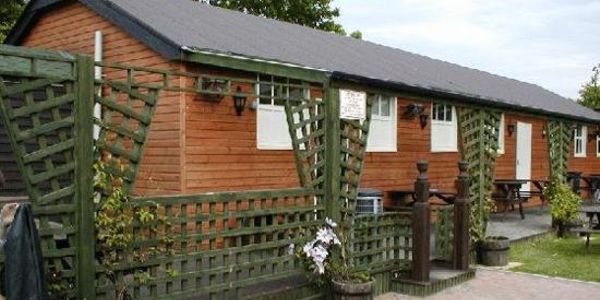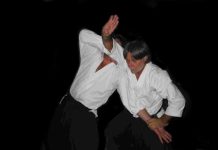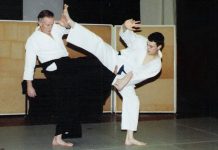In 1957, I (Henry Ellis) was studying Judo and Karate at the Abbe School of Budo at the “Hut” in Hillingdon, Middlesex, a suburb of London. My teacher was Ken Williams Sensei, and we were all students of Kenshiro Abbe Sensei (8th dan in Judo, 6th dan in Aikido, and 5th dan in Karate and Kendo). At that time, very few people in the United Kingdom had heard of Aikido.
Around 1957, Abbe Sensei told Mr Williams that he had received a letter from O-Sensei saying that instructors outside of Japan had permission to teach Aikido to anyone who wished to learn it. Mr Williams was Abbe Sensei’s first student of Aikido in Great Britain. Eventually, Abbe Sensei made Mr Williams National Coach for Aikido, and I became Mr Williams assistant – which I remained for approximately 15 years.
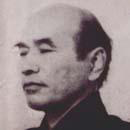 Abbe Sensei’s Aikido was the pre-war style of Aiki-Jutsu, which was very physical. Both Abbe Sensei and Williams Sensei were excellent teachers, who worked very hard to train us while promoting Aikido to an initially unreceptive public. Abbe Sensei and Williams brought eight of us up to 1st dan. At the time, we were the only dan grades in Aikido in Great Britain, and we were all in one dojo. Sunday morning practice was for dan grades only. Williams Sensei would lock the doors to the dojo, and the real serious practice would start. Williams Sensei would allow the younger dan grades to try and prove themselves against him, but they had no success.
Abbe Sensei’s Aikido was the pre-war style of Aiki-Jutsu, which was very physical. Both Abbe Sensei and Williams Sensei were excellent teachers, who worked very hard to train us while promoting Aikido to an initially unreceptive public. Abbe Sensei and Williams brought eight of us up to 1st dan. At the time, we were the only dan grades in Aikido in Great Britain, and we were all in one dojo. Sunday morning practice was for dan grades only. Williams Sensei would lock the doors to the dojo, and the real serious practice would start. Williams Sensei would allow the younger dan grades to try and prove themselves against him, but they had no success.
Williams Sensei started to visit other dojos and to introduce Aikido in Great Britain. He was a highly respected Judo teacher, and this helped him to arrange visits to Judo clubs. Occasionally, a Judo instructor would allow a few students to practice Aikido in a corner of the mat.
In the early days, the training was extremely difficult with the emphasis on very strenuous exercise. My students and I used to train four or five nights a week as well as Sunday mornings. After running for several miles, we would return to the mat and perform 200 push-ups on the backs of our wrists, which we then followed with general practice and a further two hours of hard practice.
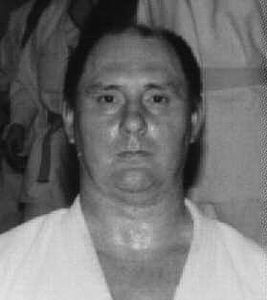 When I was graded 1st dan by Abbe Sensei, Williams Sensei instructed me to take a good student as an assistant. I chose a young man of 17 years of age by the name of Derek Eastman, who is now 3rd dan and Technical Director or our Basingstoke Headquarters. Mr Eastman is still a loyal friend after all these years.
When I was graded 1st dan by Abbe Sensei, Williams Sensei instructed me to take a good student as an assistant. I chose a young man of 17 years of age by the name of Derek Eastman, who is now 3rd dan and Technical Director or our Basingstoke Headquarters. Mr Eastman is still a loyal friend after all these years.
When Mr Eastman reached 1st dan and I was 2nd dan, William Sensei advised us to travel and spread the word of Aikido. Both Mr Eastman and I gave up our jobs and travelled around the United Kingdom. It was very difficult to introduce Aikido, because most people had never heard of it.
Mr Eastman and I left home and headed for the Midlands without much money or hope. We would visit Judo and Karate clubs, sports centres, etc. In some areas, where Williams sensei had already introduced Aikido, we would find accommodation with the students, and we would get paid a small fee for teaching. Where there was no Aikido at all, we would take jobs for a few days to feed ourselves. In one area, we worked as assistants to a funeral director. We had to goto the morgue, collect the bodies. And take them upto the chapel. (Once the boss caught me in the chapel of rest with a young local maiden whom I was laying to rest – one who was alive and well. He was very angry.)
We also worked as road sweepers, wearing bowler hats which attracted a great deal of attention from the girls.
In the north of England, the girls loved to hear the London or southern accent, and this was a great help with invitations for dinner. But it was still a struggle to survive.
We also worked in steel factories and had many other jobs around the country. Without a doubt, the worst was repairing an old railway line. We called it the “railway of death.” Needless to say, we did not stay on that job very long.
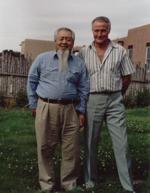 The author with Nakazono Sensei, Santa Fe, NM (1991)
The author with Nakazono Sensei, Santa Fe, NM (1991)
Still as I look back on life in Aikido, I think that this is was a really great time. As with all memories, we tend to forget the bad times and remember the good. We contributed greatly to the promotion of Aikido, and I do not regret one day of it.
Williams Sensei would send out all the Dan grades out to teach and to demonstrate in the hope that people would watch us and listen to us. Our teaching was free of charge, and this often enabled us to obtain free accommodation with the students. Although Williams Sensei was not a particularly religious man, I remember him saying, “You are my disciples, and now you must go out and teach the gospel of Aikido.”
In the earley 60’s, Williams Sensei called all the Dan grades together and said that he wanted us to attend the longest and most important seminar to date. It was to be held in Cardiff in Wales. The demonstrations and interviews were to be televised.
As usual, our accommodations were to be with local students. When we arrived at the Cardiff dojo – Williams Sensei and eight Dan grades – all the students crowded around saying, “Sensei, would you please stay with me?” One student politely took my arm and said, “Sensei I would be very pleased if you would stay with me at Sunnybank Farm.” After living in London, I thought it would be a great treat for me to stay at the farm for the weekend.
The student and I drove for miles into the wilds of rural Wales, eventually arriving at a very remote farmhouse. The weather seemed very cold but dry.
I woke up the next morning at 5am with cocks crowing and the cows doing whatever cows do to create noise. After I shock my head and realized where I was, I looked out of the window. To my horror, I saw that the snow had fallen and drifted right up to the bedroom windows.
We were snowed in for three days until a neighbour from miles away dug us out with a mechanical digger. I missed the seminar and the television appearance. It was then that I resolved to stay a city boy.
When Abbe Sensei told us that he had invited a new teacher from Japan to visit us, we were all quite excited. We had never seen a Japanese Aikido master other then Abbe Sensei.
The new teacher was Nakazono Sensei (then 6th Dan). Abbe Sensei told us that Nakazono Sensei would teach us for two weeks. It was two weeks of hell. Nakazono Sensei had us practicing on the mat for three hours in the morning and three hours in the afternoon, and then the dan grades had to practice an additional three hours in the evening. During this seminar there were many broken bones and other injuries.
Abbe Sensei had taught us to be strong and not be thrown unless the technique was effective – that being strong showed respect for your teacher. He also taught ukes to attack on balance so as not make the throw to easy. As he taught, Abbe Sensei would hit us with a shinai and explain that, while his English was not very good, the shinai spoke English fluently. So, in those early years, that was what we knew – the strong fighting art of Aikido
At first, when Nakazono Sensei saw how we practiced, he was angry with us and perplexed. He did not understand. But, at the end of the seminar, Abbe Sensei explained why we were the way we were. Then Nakazono Sensei realized that we were genuine students with great respect for him and a strong desire to learn.
In England, after a hard practice, it is traditional to finish the evening off with a pint of beer at the local pub. But Nakazono Sensei was keeping us on the mat until 10pm, and the pubs closed at 10:30pm. So Williams Sensei said to me, “Ellis, as my assistant, it is your duty to ask Sensei if we can leave the mat at 9pm so we can have time to get to the pub.” I asked Nakazono Sensei (what a fool I was!), and he became angry. He said that he had travelled across the world to teach us Aikido and that all we wanted to do was go to the pub. What he didn’t seem to understand was that this was our vacation from work. (I reminded Nakazono Sensei of this incident when we met later in Santa Fe, and we were able to laugh about it.)
In 1963, I was Nakazono Sansei’s assistant at a national martial arts demonstration at the Royal Albert Hall in London. That was a proud moment for me, and also for my parents, as this was the first they had ever seen me in a Aikido demonstration.
There was a vast difference between Abbe Sensei’s old style Aikido and Nakazono Sensei’s new style, which was far more flowing. The new way seemed so much softer and yet very strong.
We quickly adapted to this new style. Then Abbe Sensei dropped a “bombshell” on us: we would all have to be regraded to meet the current standards of Hombu Dojo. The grading was physical and mentally demanding. At its end, Abbe Sensei lined all the eight Dan grades up and said that he accepted our ranks – with the exception of one. He looked at that one for a timeless moment and said, “Necessary sell your gi while price is high.” Even after 37 years, I have not forgotten that sentence. Abbe Sensei took away that students rank.
In the early 1960’s I was asked to conduct an Aikido demonstration at the British Judo Council’s National Judo Championships in London. Among the VIPs in attendance were the Japanese Ambassador and Lady Baden Powell, the wife of Lord Baden Powell, who was then the head of the World Organization of Boy Scouts. Kenshiro Abbe and Otani Sensei emphasized how important this evening was and that they wanted an impressive display from the Aikido people.
While we were waiting to go on, a Judo man came up to Otani Sensei who was speaking to the Japanese Ambassador, and said, “Hey, Smiler.” I couldn’t believe the disrespect, and took the man to one side. We were having a confrontation when Derek Eastman, who was outside smoking a cigarette, told me that we were due on stage immediately. We rushed onto the stage.
As I performed the first technique, Mr.Eastman’s cigarettes and matches fell out of his gi onto the stage. I was already upset from the incident with the Judo man, and now the embarrassment! I smashed Mr Eastman all over the tatami and back again.
Later, when we were doing a knife technique with a live blade the knife went through my gi and I felt the cold blade against my stomach. I thought, “My God, it’s in me!” I dropped onto my knees with Mr Eastman in an immobilization, and I looked down at the front row. Looking up at me with shock and horror was her Ladyship. I knew by the look on her face that any hopes we had of her sponsoring Aikido were over.
After the display, her Ladyship said, “That was the most horrific display of violence I have ever witnessed.”
The Japanese Ambassador congratulated us on a excellent demonstration. (On inspection, I realized that the blade had only grazed me.)
Abbe Sensei brought over from Paris a young 5th Dan, Noro Sensei – the first sensei we had seen in a white hakama. Noro Sensei was perhaps the most graceful of all the teachers I have ever seen to date.
There then followed many other teachers: Tada Sensei, Hishomura Sensei, Tadashi Abbe Sensei, Tamura Sensei and Chiba Sensei. I was with Chiba Sensei for several years.
Chiba Sensei and I taught Aikido in a dojo at The Times newspaper in London. We were asked to take part in a 30-minute broadcast on the BBC world radio. Sensei asked me to do all the talking because, at the time his English was not very good. A television producer who had heard the broadcast asked if we would do a demonstration on Anglican TV. We agreed.
While we were waiting for our slot on TV, we were taken to a hospitality room, where the had just about any drink you can imagine. The hostess asked if we would like drinks. I thought a Jim Beam would go down well, and I said, “Sensei can we have a drink?” “Yes,” he replied, but before I could order my Jim Beam he ordered two orange juices.
Some of the Aikido I have seen in recent years depresses me because it can only be done by two Aikidoists who practice together on a regular basis – like a pair of dancers who know each others moves. But Chiba Sensei’s style of Aikido is effective. If I wanted Yoga, I would study; if I wanted dance, I would take dancing lessons. I believe that Aikido not only has to look good, but also be effective.
Once I had to go to see Abbe Sensei at his apartment in Acton, London. (He shared a house with Otani Sensei, a 7th Dan in Judo, and his son Tomio Otani, a good friend of mine who was the national coach for Kendo.)
The house was like a martial arts museum with suits of armour, swords, and other weapons scattered around.
From childhood, athletics has been one of my great loves. But the one sport I cannot watch is our English game of cricket. So you can imagine my disappointment when I came to the house and found Abbe Sensei, Whom I viewed almost like a god, watching the cricket, “The World Series.” The windows were open, and small birds and pigeons were flying around the room.
Carefully choosing my words, I said, “Sensei, I didn’t realize that you liked cricket.”
“I don’t,” he said. “I watch this boring, stupid game every day, and still don’t understand it.”
He then said something very true: “They call it the World Series, but it is only played in countries that Britain conquered.”
Eventually, Williams Sensei, whom I believe to the best Aikidoist the United Kingdom has ever produced, began studying Ki Aikido with Tohei Sensei while a group to while I belong remained traditional.
Williams Sensei strictly controlled Aikido in the United Kingdom for approximately 15 years. No one would start a dojo or take a seminar without consulting with him first. But Aikido has now grown far beyond our early expectations, and many factors have broken up the special unit of dan grades that once existed.
I was not politically minded in the old days, and I have not changed. Sometimes students telephone me and ask what style I practiceor what organization I belong to. Before they tell me their allegiance, I just say, “if you practice Aikido, you are more than welcome to attend our dojo.”
On my next visit to the US, I hope to visit Alaska. The secretary of the Ellis School of Traditional Aikido (ESTA) in Alamogordo, Mrs. Aida Prazak, has moved to North Pole in Alaska, with her husband, who is a captain in the United States Air Force, and she hopes to open an Aikido school in the area in the near future.
When I was last in the United States, I taught in New Mexico at the El Paso University, where I received a very warm welcome. I also taught at Roswell Military Academy and Holloman Air Force Base.
When I last saw Nakazono Sensei he asked, “What are you doing now?” I told him how things were. He said, “Henry, you think you are only 20 years of age. You should slow down. You are a old man.” But, if I refrain from looking in the mirror, I can go on pretending I am a young man in heart and mind – thanks to a lifetime of Aikido.


